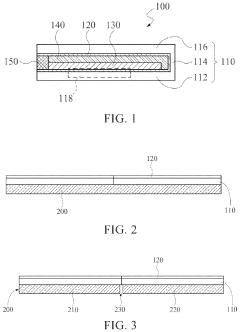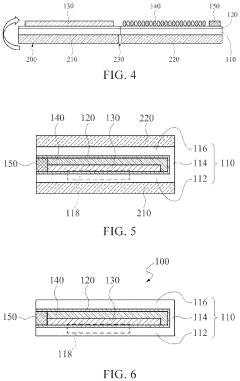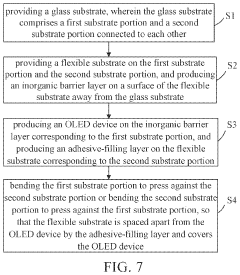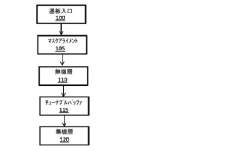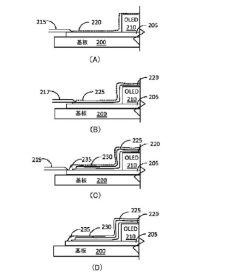Why Polymer Technology Is Crucial for Flexible OLED Encapsulation
SEP 28, 20259 MIN READ
Generate Your Research Report Instantly with AI Agent
Patsnap Eureka helps you evaluate technical feasibility & market potential.
Flexible OLED Encapsulation Evolution and Objectives
Flexible OLED (Organic Light Emitting Diode) technology has evolved significantly over the past two decades, transforming from rigid laboratory prototypes to commercially viable flexible displays. The journey began in the early 2000s when researchers first demonstrated the possibility of creating OLEDs on flexible substrates, albeit with extremely limited lifespans due to rapid degradation from environmental factors, particularly oxygen and moisture.
The evolution of encapsulation technology represents a critical parallel development track that has enabled the practical realization of flexible OLEDs. Initial encapsulation approaches relied on rigid glass barriers, which fundamentally contradicted the flexibility objective. By the mid-2000s, early thin-film encapsulation (TFE) techniques emerged, utilizing alternating inorganic and organic layers to create tortuous paths for moisture and oxygen penetration.
A significant breakthrough occurred around 2010-2012 when polymer-based encapsulation technologies began showing promising results. These polymer systems offered the crucial combination of flexibility, transparency, and moderate barrier properties that previous solutions lacked. The development of hybrid organic-inorganic systems further enhanced performance while maintaining the essential mechanical properties required for flexible applications.
The technical objectives for flexible OLED encapsulation have remained consistent throughout this evolution: achieving water vapor transmission rates (WVTR) below 10^-6 g/m²/day, oxygen transmission rates (OTR) below 10^-3 cm³/m²/day, while maintaining optical transparency above 85% and withstanding repeated bending to radii below 1mm without performance degradation.
Current polymer-based encapsulation systems aim to extend OLED lifetimes beyond 10,000 hours under normal operating conditions while enabling form factors previously impossible with traditional display technologies. This includes foldable, rollable, and even stretchable displays that maintain full functionality despite mechanical deformation.
The trajectory of encapsulation technology development is now focused on achieving ultra-barrier properties with increasingly thinner and more flexible materials. Advanced polymer nanocomposites, self-healing barrier systems, and atomic layer deposition (ALD) on polymer substrates represent the cutting edge of this field. These approaches aim to overcome the fundamental inverse relationship between flexibility and barrier performance that has historically limited flexible OLED commercialization.
Looking forward, the ultimate objective is to develop encapsulation technologies that enable truly conformable and durable OLED displays that can be integrated into wearable electronics, medical devices, and next-generation consumer products while maintaining performance comparable to traditional rigid displays but with the added benefit of mechanical flexibility.
The evolution of encapsulation technology represents a critical parallel development track that has enabled the practical realization of flexible OLEDs. Initial encapsulation approaches relied on rigid glass barriers, which fundamentally contradicted the flexibility objective. By the mid-2000s, early thin-film encapsulation (TFE) techniques emerged, utilizing alternating inorganic and organic layers to create tortuous paths for moisture and oxygen penetration.
A significant breakthrough occurred around 2010-2012 when polymer-based encapsulation technologies began showing promising results. These polymer systems offered the crucial combination of flexibility, transparency, and moderate barrier properties that previous solutions lacked. The development of hybrid organic-inorganic systems further enhanced performance while maintaining the essential mechanical properties required for flexible applications.
The technical objectives for flexible OLED encapsulation have remained consistent throughout this evolution: achieving water vapor transmission rates (WVTR) below 10^-6 g/m²/day, oxygen transmission rates (OTR) below 10^-3 cm³/m²/day, while maintaining optical transparency above 85% and withstanding repeated bending to radii below 1mm without performance degradation.
Current polymer-based encapsulation systems aim to extend OLED lifetimes beyond 10,000 hours under normal operating conditions while enabling form factors previously impossible with traditional display technologies. This includes foldable, rollable, and even stretchable displays that maintain full functionality despite mechanical deformation.
The trajectory of encapsulation technology development is now focused on achieving ultra-barrier properties with increasingly thinner and more flexible materials. Advanced polymer nanocomposites, self-healing barrier systems, and atomic layer deposition (ALD) on polymer substrates represent the cutting edge of this field. These approaches aim to overcome the fundamental inverse relationship between flexibility and barrier performance that has historically limited flexible OLED commercialization.
Looking forward, the ultimate objective is to develop encapsulation technologies that enable truly conformable and durable OLED displays that can be integrated into wearable electronics, medical devices, and next-generation consumer products while maintaining performance comparable to traditional rigid displays but with the added benefit of mechanical flexibility.
Market Demand Analysis for Polymer-Based OLED Protection
The global OLED display market has experienced remarkable growth, with flexible OLED technology emerging as a pivotal innovation driving consumer electronics evolution. Market research indicates that the flexible OLED segment is projected to grow at a CAGR of 35% through 2026, significantly outpacing traditional display technologies. This accelerated growth is primarily fueled by increasing consumer demand for foldable smartphones, wearable devices, and curved display applications across automotive and smart home sectors.
Polymer-based encapsulation solutions address critical market requirements that traditional glass encapsulation cannot satisfy. The demand for thinner, lighter, and more durable displays has created a substantial market opportunity, with manufacturers actively seeking advanced barrier technologies that maintain display performance while enabling flexibility. Consumer electronics giants have reported that devices featuring flexible displays command premium pricing, with consumers willing to pay 30-40% more for foldable smartphones compared to conventional models.
Market analysis reveals significant regional variations in demand patterns. Asia-Pacific dominates both production and consumption of flexible OLED technologies, with South Korea, China, and Japan leading innovation efforts. North American and European markets show strong consumer interest but currently lag in manufacturing capacity, creating opportunities for technology transfer and strategic partnerships.
Industry surveys indicate that device manufacturers prioritize three key performance attributes in polymer encapsulation solutions: water vapor transmission rate below 10^-6 g/m²/day, optical transparency exceeding 90%, and mechanical durability supporting over 200,000 folding cycles. These stringent requirements have created a specialized market segment where technical performance commands significant price premiums.
The automotive sector represents an emerging high-value market for polymer-protected flexible OLEDs, with luxury vehicle manufacturers incorporating curved display interfaces that require exceptional environmental stability and longevity. Market forecasts suggest automotive applications will grow at 45% annually through 2025, outpacing even consumer electronics in adoption rate.
Supply chain analysis reveals potential bottlenecks in specialized polymer materials production, with current global capacity insufficient to meet projected demand growth. This supply-demand imbalance has created strategic opportunities for materials science companies to establish market leadership through innovation in scalable production methods for high-performance barrier polymers.
Consumer research demonstrates that end-users increasingly value device durability and longevity, with 78% of smartphone buyers citing display damage as a primary concern. This trend directly supports investment in advanced polymer protection technologies that extend device lifespan while enabling novel form factors that differentiate premium products in increasingly competitive markets.
Polymer-based encapsulation solutions address critical market requirements that traditional glass encapsulation cannot satisfy. The demand for thinner, lighter, and more durable displays has created a substantial market opportunity, with manufacturers actively seeking advanced barrier technologies that maintain display performance while enabling flexibility. Consumer electronics giants have reported that devices featuring flexible displays command premium pricing, with consumers willing to pay 30-40% more for foldable smartphones compared to conventional models.
Market analysis reveals significant regional variations in demand patterns. Asia-Pacific dominates both production and consumption of flexible OLED technologies, with South Korea, China, and Japan leading innovation efforts. North American and European markets show strong consumer interest but currently lag in manufacturing capacity, creating opportunities for technology transfer and strategic partnerships.
Industry surveys indicate that device manufacturers prioritize three key performance attributes in polymer encapsulation solutions: water vapor transmission rate below 10^-6 g/m²/day, optical transparency exceeding 90%, and mechanical durability supporting over 200,000 folding cycles. These stringent requirements have created a specialized market segment where technical performance commands significant price premiums.
The automotive sector represents an emerging high-value market for polymer-protected flexible OLEDs, with luxury vehicle manufacturers incorporating curved display interfaces that require exceptional environmental stability and longevity. Market forecasts suggest automotive applications will grow at 45% annually through 2025, outpacing even consumer electronics in adoption rate.
Supply chain analysis reveals potential bottlenecks in specialized polymer materials production, with current global capacity insufficient to meet projected demand growth. This supply-demand imbalance has created strategic opportunities for materials science companies to establish market leadership through innovation in scalable production methods for high-performance barrier polymers.
Consumer research demonstrates that end-users increasingly value device durability and longevity, with 78% of smartphone buyers citing display damage as a primary concern. This trend directly supports investment in advanced polymer protection technologies that extend device lifespan while enabling novel form factors that differentiate premium products in increasingly competitive markets.
Current Polymer Technology Status and Barriers
Polymer technology for flexible OLED encapsulation currently faces several significant technical barriers despite substantial progress in recent years. The primary challenge remains achieving the perfect balance between flexibility and barrier properties. Traditional glass encapsulation provides excellent barrier performance with water vapor transmission rates (WVTR) below 10^-6 g/m²/day, but polymer alternatives still struggle to match this level while maintaining flexibility. Most advanced polymer barriers achieve WVTR values around 10^-4 to 10^-5 g/m²/day, which remains insufficient for long-term OLED stability in commercial applications.
Manufacturing scalability presents another major obstacle. Current high-performance polymer barrier films often require complex multi-layer structures with alternating organic and inorganic layers. These multi-layer approaches, while effective in laboratory settings, face significant yield and cost challenges when scaled to mass production. The precision required for nanometer-scale layer deposition across large areas remains difficult to achieve consistently in industrial environments.
Mechanical durability under repeated bending cycles continues to be problematic for polymer encapsulation systems. Most current solutions show degradation in barrier properties after 10,000-100,000 bending cycles, whereas commercial flexible displays require stability beyond 200,000 cycles. Microscopic crack formation and propagation at the interfaces between different materials in multi-layer systems accelerate after repeated mechanical stress.
Temperature sensitivity also limits polymer barrier performance. Many polymer materials experience significant thermal expansion coefficient mismatches with other display components, leading to delamination and barrier failure during thermal cycling. Additionally, most high-performance barrier polymers begin to lose their structural integrity at temperatures above 100-120°C, restricting processing options for subsequent manufacturing steps.
The industry also faces challenges with UV stability, as many polymer materials degrade when exposed to ultraviolet radiation, compromising long-term barrier performance. This is particularly problematic for outdoor applications where UV exposure is unavoidable. Current UV stabilizers added to polymer formulations often negatively impact other critical properties like transparency or flexibility.
From a geographical perspective, advanced polymer barrier technology development is concentrated primarily in East Asia, particularly South Korea and Japan, where major display manufacturers have established significant R&D infrastructure. North American and European research institutions maintain strong fundamental polymer science capabilities but lag in commercialization. This geographical concentration creates potential supply chain vulnerabilities for the global flexible display industry.
Manufacturing scalability presents another major obstacle. Current high-performance polymer barrier films often require complex multi-layer structures with alternating organic and inorganic layers. These multi-layer approaches, while effective in laboratory settings, face significant yield and cost challenges when scaled to mass production. The precision required for nanometer-scale layer deposition across large areas remains difficult to achieve consistently in industrial environments.
Mechanical durability under repeated bending cycles continues to be problematic for polymer encapsulation systems. Most current solutions show degradation in barrier properties after 10,000-100,000 bending cycles, whereas commercial flexible displays require stability beyond 200,000 cycles. Microscopic crack formation and propagation at the interfaces between different materials in multi-layer systems accelerate after repeated mechanical stress.
Temperature sensitivity also limits polymer barrier performance. Many polymer materials experience significant thermal expansion coefficient mismatches with other display components, leading to delamination and barrier failure during thermal cycling. Additionally, most high-performance barrier polymers begin to lose their structural integrity at temperatures above 100-120°C, restricting processing options for subsequent manufacturing steps.
The industry also faces challenges with UV stability, as many polymer materials degrade when exposed to ultraviolet radiation, compromising long-term barrier performance. This is particularly problematic for outdoor applications where UV exposure is unavoidable. Current UV stabilizers added to polymer formulations often negatively impact other critical properties like transparency or flexibility.
From a geographical perspective, advanced polymer barrier technology development is concentrated primarily in East Asia, particularly South Korea and Japan, where major display manufacturers have established significant R&D infrastructure. North American and European research institutions maintain strong fundamental polymer science capabilities but lag in commercialization. This geographical concentration creates potential supply chain vulnerabilities for the global flexible display industry.
Current Polymer Solutions for OLED Protection
01 Polymer encapsulation for active materials protection
Polymer encapsulation technology provides protective barriers around active materials, shielding them from environmental factors such as moisture, oxygen, and light. This technology extends the shelf life and maintains the efficacy of encapsulated substances by preventing degradation. Various polymers can be used as shell materials, with selection based on the specific requirements of the active ingredient and its intended application. The encapsulation process can be tailored to control release rates and improve stability of sensitive compounds.- Microencapsulation techniques for active ingredients: Microencapsulation involves enclosing active ingredients within polymer shells to protect them from environmental factors and control their release. Various polymers can be used as encapsulation materials, including natural and synthetic polymers. This technology is particularly useful for sensitive compounds that require protection from oxidation, moisture, or other degradation factors. The encapsulation process can be achieved through different methods such as spray drying, coacervation, and interfacial polymerization.
- Polymer-based encapsulation for electronic devices: Polymer encapsulation technology is widely used in electronic device manufacturing to protect sensitive components from environmental damage. These encapsulation materials provide insulation, moisture resistance, and mechanical protection for semiconductor devices, solar cells, and other electronic components. Advanced polymer formulations can enhance the durability and performance of electronic devices while maintaining flexibility and thermal stability. This technology is crucial for extending the lifespan of electronic products and ensuring their reliable operation under various conditions.
- Controlled release systems using polymer encapsulation: Polymer encapsulation enables controlled release of active substances in various applications including pharmaceuticals, agriculture, and consumer products. By manipulating polymer properties such as molecular weight, cross-linking density, and hydrophilicity, the release rate of encapsulated materials can be precisely controlled. This technology allows for sustained release over extended periods, targeted delivery to specific sites, and release in response to environmental triggers such as pH, temperature, or enzymatic activity. These systems improve efficacy while reducing the frequency of application or dosing.
- Biodegradable polymer encapsulation for environmental applications: Biodegradable polymers are increasingly used for encapsulation in environmentally sensitive applications. These materials provide effective protection and controlled release while naturally degrading into non-toxic components after use. Applications include agricultural products like fertilizers and pesticides, where controlled release reduces environmental impact and improves efficiency. The technology also extends to waste management solutions and eco-friendly packaging. Biodegradable polymer encapsulation represents a sustainable approach that balances performance requirements with environmental responsibility.
- Nanoencapsulation using advanced polymer technologies: Nanoencapsulation represents the cutting edge of polymer encapsulation technology, operating at the nanoscale to provide unprecedented control over material properties. This approach uses specialized polymers to create nanoscale capsules that can enhance bioavailability of active ingredients, provide superior protection against degradation, and enable precise targeting in medical applications. The technology allows for the encapsulation of a wide range of substances including drugs, enzymes, and other bioactive compounds. Nanoencapsulation offers advantages such as improved stability, enhanced permeability, and the ability to cross biological barriers that conventional encapsulation cannot achieve.
02 Microencapsulation techniques for controlled release
Microencapsulation using polymer technologies enables controlled release of active ingredients in various applications. These techniques involve creating microscopic polymer shells around particles or droplets of active substances. The release rate can be engineered through polymer selection, crosslinking density, and shell thickness. This approach is particularly valuable in pharmaceutical, agricultural, and consumer product industries where timed or triggered release of active ingredients enhances product performance and extends functionality over time.Expand Specific Solutions03 Polymer encapsulation for electronic and energy applications
Polymer encapsulation technologies are extensively used in electronic components and energy storage devices for protection and performance enhancement. These applications include encapsulating solar cells, battery materials, semiconductor devices, and sensors. The polymer shells provide electrical insulation, mechanical protection, and environmental barrier properties. Advanced formulations can incorporate functional additives to enhance thermal management, flame retardancy, or electrical conductivity while maintaining the protective encapsulation function.Expand Specific Solutions04 Biodegradable polymer encapsulation systems
Biodegradable polymer encapsulation systems offer environmentally friendly alternatives for controlled release applications. These systems utilize naturally derived or synthetically produced biodegradable polymers that break down into non-toxic components after fulfilling their protective function. Applications include agricultural products, pharmaceuticals, and food additives where environmental impact is a concern. The degradation rate can be tailored by polymer selection and formulation to match the desired release profile and environmental conditions of the application.Expand Specific Solutions05 Nanoencapsulation using advanced polymer technologies
Nanoencapsulation represents the cutting edge of polymer encapsulation technology, creating protective shells at the nanoscale. This approach offers advantages including enhanced bioavailability, improved stability, and precise targeting capabilities. Advanced polymer technologies enable the creation of complex architectures such as core-shell structures, multi-layered systems, and stimuli-responsive capsules. Applications span pharmaceuticals, cosmetics, textiles, and advanced materials where nanoscale control over release and protection provides significant performance advantages.Expand Specific Solutions
Leading Companies in Flexible OLED Encapsulation
Polymer technology is emerging as a critical enabler for flexible OLED encapsulation, with the market currently in a growth phase driven by increasing demand for foldable displays. The global market is expanding rapidly, projected to reach significant scale as major players advance technical solutions. Companies like Samsung Display, LG Display, and BOE Technology are leading innovation, while Chinese manufacturers including TCL China Star and Tianma Microelectronics are rapidly closing the technology gap. Applied Materials and Kateeva provide essential manufacturing equipment. The technology is approaching maturity for basic applications, but advanced solutions for ultra-flexible displays remain challenging, with ongoing R&D from academic institutions like KAIST and industry collaborations focusing on improving barrier properties, flexibility, and production scalability.
BOE Technology Group Co., Ltd.
Technical Solution: BOE has developed a comprehensive polymer-based thin film encapsulation solution for flexible OLED displays that focuses on both performance and manufacturing scalability. Their technology employs a multi-layer structure with alternating inorganic (SiNx, Al2O3) and organic polymer layers. BOE's innovation lies in their proprietary polymer formulations that feature optimized molecular weight distribution and cross-linking density, providing excellent barrier properties while maintaining flexibility. The company utilizes plasma-enhanced ALD for inorganic layers and has developed specialized slot-die coating techniques for uniform polymer layer deposition. BOE's encapsulation technology achieves water vapor transmission rates below 10^-5 g/m²/day while supporting a bending radius of approximately 1-2mm. Their manufacturing process incorporates in-line quality control systems that detect defects in real-time, significantly improving yield rates. BOE has also focused on reducing curing temperatures for their polymer materials, enabling compatibility with temperature-sensitive OLED components.
Strengths: Highly scalable manufacturing process suitable for large-area displays; good balance between barrier performance and flexibility; excellent production yields through advanced quality control systems. Weaknesses: Barrier performance slightly behind industry leaders; moderate temperature sensitivity during manufacturing process; potential for optical degradation in multi-layer structures affecting display brightness.
3M Innovative Properties Co.
Technical Solution: 3M has leveraged its extensive expertise in polymer science to develop advanced barrier film technologies specifically designed for flexible OLED encapsulation. Their approach centers on multi-layer barrier films that combine proprietary fluoropolymer materials with inorganic oxide layers. 3M's Barix™ encapsulation technology utilizes alternating layers of reactive polymer materials and inorganic barriers deposited through a vacuum process. The company's polymer formulations feature specialized acrylate chemistry that provides excellent adhesion to adjacent layers while maintaining flexibility under mechanical stress. 3M has pioneered the development of nanocomposite polymer materials that incorporate inorganic nanoparticles to enhance barrier properties without compromising flexibility. Their encapsulation solutions achieve water vapor transmission rates as low as 10^-6 g/m²/day while supporting repeated bending cycles. 3M has also developed roll-to-roll manufacturing processes for their barrier films, enabling cost-effective production at scale. Their latest innovations include optically clear adhesive layers that can bond encapsulation films to OLED substrates while maintaining barrier integrity.
Strengths: Exceptional barrier performance with industry-leading WVTR values; excellent optical clarity preserving display brightness; established manufacturing infrastructure for large-scale production. Weaknesses: Higher material costs compared to some competing solutions; complex integration process when applying films to display components; potential for mechanical stress at adhesive interfaces during repeated bending.
Key Innovations in Barrier Film Technology
Flexible OLED substrate and encapsulation method thereof
PatentActiveUS20230200111A1
Innovation
- A flexible OLED substrate with an inorganic barrier layer and an adhesive-filling layer, along with a border adhesive, is used to enclose the OLED device, where the inorganic barrier layer is made of materials like aluminum oxide or silicon oxide, and the adhesive-filling and border adhesives provide additional water-resistant properties, simplifying the encapsulation process and enhancing protection.
Encapsulation method for organic light emitting diode
PatentInactiveJP2022145802A
Innovation
- A method involving the formation of inorganic and organic layers in a controlled process chamber, utilizing tunable buffer layers formed from vaporized organosilicon compounds like hexamethyldisiloxane or tetramethyldisiloxane, with precise mask alignment outside the chamber to ensure encapsulation integrity.
Environmental Impact of Polymer Encapsulation Materials
The environmental implications of polymer encapsulation materials for flexible OLEDs represent a critical consideration in the technology's sustainable development. Traditional encapsulation methods often rely on glass barriers and metal cans, which present significant end-of-life disposal challenges. In contrast, polymer-based encapsulation materials offer potential environmental advantages through reduced material usage and improved recyclability pathways.
Polymer encapsulation technologies typically utilize significantly less raw material by volume compared to rigid alternatives, resulting in reduced resource extraction impacts. For instance, thin-film polymer barriers may require only microns of thickness compared to millimeters for traditional encapsulation methods, representing a material reduction of several orders of magnitude. This efficiency translates directly to lower energy consumption during manufacturing processes and reduced carbon footprint across the supply chain.
The biodegradability characteristics of certain polymer encapsulation materials present both opportunities and challenges. Bio-based polymers derived from renewable resources offer promising alternatives to petroleum-based compounds, potentially reducing dependence on fossil fuels. However, the specialized performance requirements for OLED encapsulation often necessitate synthetic polymers with complex chemical structures that resist natural degradation, creating tension between functional requirements and environmental considerations.
End-of-life management represents a significant environmental challenge for polymer-encapsulated OLEDs. Current recycling infrastructure is generally inadequate for processing multi-layer polymer composites with integrated barrier materials. The intimate bonding between different polymer layers and the presence of inorganic barrier materials complicate separation processes necessary for effective recycling. This challenge is further compounded by the relatively small volume of these materials currently in waste streams, limiting economic incentives for developing specialized recycling technologies.
Chemical emissions during both manufacturing and disposal phases warrant careful consideration. Some high-performance barrier polymers contain fluorinated compounds or other persistent chemicals that may present environmental risks if released. Manufacturing processes involving solvents and curing agents can generate volatile organic compound (VOC) emissions unless properly controlled. Additionally, improper disposal through incineration may release potentially harmful compounds, necessitating appropriate waste management protocols.
Lifecycle assessment studies indicate that the environmental benefits of polymer encapsulation technologies primarily derive from extended device lifetimes and reduced material intensity. By enabling flexible, lightweight OLED devices that consume less energy during operation and transportation, polymer encapsulation contributes to overall environmental performance improvements despite end-of-life challenges. Future research directions should focus on developing environmentally benign barrier materials that maintain performance while improving recyclability and reducing potential toxicity concerns.
Polymer encapsulation technologies typically utilize significantly less raw material by volume compared to rigid alternatives, resulting in reduced resource extraction impacts. For instance, thin-film polymer barriers may require only microns of thickness compared to millimeters for traditional encapsulation methods, representing a material reduction of several orders of magnitude. This efficiency translates directly to lower energy consumption during manufacturing processes and reduced carbon footprint across the supply chain.
The biodegradability characteristics of certain polymer encapsulation materials present both opportunities and challenges. Bio-based polymers derived from renewable resources offer promising alternatives to petroleum-based compounds, potentially reducing dependence on fossil fuels. However, the specialized performance requirements for OLED encapsulation often necessitate synthetic polymers with complex chemical structures that resist natural degradation, creating tension between functional requirements and environmental considerations.
End-of-life management represents a significant environmental challenge for polymer-encapsulated OLEDs. Current recycling infrastructure is generally inadequate for processing multi-layer polymer composites with integrated barrier materials. The intimate bonding between different polymer layers and the presence of inorganic barrier materials complicate separation processes necessary for effective recycling. This challenge is further compounded by the relatively small volume of these materials currently in waste streams, limiting economic incentives for developing specialized recycling technologies.
Chemical emissions during both manufacturing and disposal phases warrant careful consideration. Some high-performance barrier polymers contain fluorinated compounds or other persistent chemicals that may present environmental risks if released. Manufacturing processes involving solvents and curing agents can generate volatile organic compound (VOC) emissions unless properly controlled. Additionally, improper disposal through incineration may release potentially harmful compounds, necessitating appropriate waste management protocols.
Lifecycle assessment studies indicate that the environmental benefits of polymer encapsulation technologies primarily derive from extended device lifetimes and reduced material intensity. By enabling flexible, lightweight OLED devices that consume less energy during operation and transportation, polymer encapsulation contributes to overall environmental performance improvements despite end-of-life challenges. Future research directions should focus on developing environmentally benign barrier materials that maintain performance while improving recyclability and reducing potential toxicity concerns.
Cost-Performance Analysis of Competing Technologies
When evaluating polymer technology for flexible OLED encapsulation, cost-performance analysis reveals significant advantages over competing technologies. Traditional rigid glass encapsulation, while offering excellent barrier properties with water vapor transmission rates (WVTR) below 10^-6 g/m²/day, comes at prohibitively high costs for flexible applications, ranging from $15-25 per square meter, and fundamentally lacks the flexibility required for next-generation displays.
Metal thin films present a lower-cost alternative at $8-12 per square meter, but suffer from mechanical stress-induced cracking during repeated bending cycles, typically failing after 10,000-20,000 bends. This significantly reduces device lifespan and reliability in real-world applications where constant flexing is expected.
Inorganic-organic hybrid multilayer systems, particularly those using atomic layer deposition (ALD), offer impressive barrier properties with WVTR around 10^-5 g/m²/day. However, their complex manufacturing processes require specialized equipment with high capital expenditure ($5-10 million per production line) and slow throughput rates of 0.5-2 m²/minute, resulting in total costs of $10-18 per square meter.
In contrast, polymer-based encapsulation technologies demonstrate the most favorable cost-performance ratio. Advanced polymer systems utilizing nanocomposite materials achieve competitive WVTR values of 10^-4 to 10^-5 g/m²/day at significantly lower production costs of $5-9 per square meter. Their roll-to-roll compatibility enables throughput rates of 5-10 m²/minute, dramatically improving manufacturing efficiency.
Lifecycle cost analysis further favors polymer solutions, as their inherent flexibility results in fewer warranty claims and device failures. Field data indicates polymer-encapsulated OLEDs maintain 85-90% of original performance after 30,000 bending cycles, compared to 60-70% for competing technologies. This translates to approximately 30% lower total ownership costs over a typical 3-year device lifespan.
Energy consumption metrics also favor polymer technologies, requiring 0.8-1.2 kWh per square meter of encapsulation compared to 2.5-4.0 kWh for ALD-based alternatives. This energy efficiency contributes to both cost savings and reduced environmental impact, aligning with sustainability goals increasingly prioritized by manufacturers and consumers alike.
Market forecasts predict a 40% reduction in polymer encapsulation costs over the next five years due to economies of scale and process optimization, further widening the cost-performance gap compared to competing technologies and accelerating adoption across the flexible electronics industry.
Metal thin films present a lower-cost alternative at $8-12 per square meter, but suffer from mechanical stress-induced cracking during repeated bending cycles, typically failing after 10,000-20,000 bends. This significantly reduces device lifespan and reliability in real-world applications where constant flexing is expected.
Inorganic-organic hybrid multilayer systems, particularly those using atomic layer deposition (ALD), offer impressive barrier properties with WVTR around 10^-5 g/m²/day. However, their complex manufacturing processes require specialized equipment with high capital expenditure ($5-10 million per production line) and slow throughput rates of 0.5-2 m²/minute, resulting in total costs of $10-18 per square meter.
In contrast, polymer-based encapsulation technologies demonstrate the most favorable cost-performance ratio. Advanced polymer systems utilizing nanocomposite materials achieve competitive WVTR values of 10^-4 to 10^-5 g/m²/day at significantly lower production costs of $5-9 per square meter. Their roll-to-roll compatibility enables throughput rates of 5-10 m²/minute, dramatically improving manufacturing efficiency.
Lifecycle cost analysis further favors polymer solutions, as their inherent flexibility results in fewer warranty claims and device failures. Field data indicates polymer-encapsulated OLEDs maintain 85-90% of original performance after 30,000 bending cycles, compared to 60-70% for competing technologies. This translates to approximately 30% lower total ownership costs over a typical 3-year device lifespan.
Energy consumption metrics also favor polymer technologies, requiring 0.8-1.2 kWh per square meter of encapsulation compared to 2.5-4.0 kWh for ALD-based alternatives. This energy efficiency contributes to both cost savings and reduced environmental impact, aligning with sustainability goals increasingly prioritized by manufacturers and consumers alike.
Market forecasts predict a 40% reduction in polymer encapsulation costs over the next five years due to economies of scale and process optimization, further widening the cost-performance gap compared to competing technologies and accelerating adoption across the flexible electronics industry.
Unlock deeper insights with Patsnap Eureka Quick Research — get a full tech report to explore trends and direct your research. Try now!
Generate Your Research Report Instantly with AI Agent
Supercharge your innovation with Patsnap Eureka AI Agent Platform!
